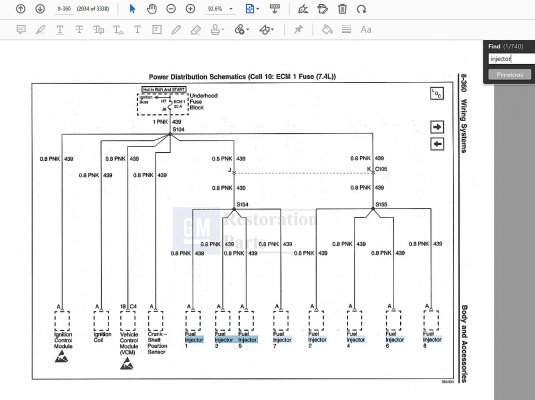So before or after the fuse is where we start to make our decision in which wire to use. In short, I guess you can cut the yellow wire that goes to the fuse and add a toggle switch, but this is thicker. Pardon my ignorance, but does cutting the yellow wire prevent the fuse from working if the switch is off and so happens to ground itself out/ short out, meaning the line isn't protected?Hello aj_08,
618 Syndicate has the best idea. Using the following wiring diagram from the
Factory Service Manual, let's see what would be the best way to implement
the 'denial of starter usage' function while you are away from your vehicle:
You must be registered for see images attach
Alright, when it comes to a relay, we can either disable it's functioning (the control side)
-or- we can allow the relay to function but interrupt the power to the load that the relay
is controlling.
To keep this short enough that it will actually be read, when you look at the circuit above,
the RED and PPL (purple) wires would be your target if you decided to interrupt the actual
current being sent to the starter solenoid. (NOTE: Note that both of these wire colors are
marked as a '3' in metric wire diameter. If you check out the attached conversion table
this translates to '12 gauge' wire that is commonly used by sparky types.)
Instead, my recommendation would be to interrupt the control side of the starter solenoid.
This way, instead of the 'momentary on' switch having to reliably carry amps of current, instead
we'll task it with making/breaking the milliamps of current required to operate the solenoid.
In addition, the RED & PPL wires are physically run between the Underhood Fuse Block and the
starter solenoid, so having to route this 12 gauge wire from the Underhood fuse block to a
switch reachable from the driver position is more work. And the shorter that a 'high current'
circuit is, the better.
**** How to test kill switch functionality prior to implementation ****
First, locate the Ignition Switch on the diagram. Notice that the switch must be turned by
the human all the way to the Start position. If you follow the wire from the Start terminal,
it then goes through the CRANK fuse. (#8 in the IP {Instrument Panel} fuse block.)
Pull that fuse, and verify that the starter is now disabled when you attempt to start your
K1500. Note that the wire feeding the fuse is yellow, and after the fuse it is a 18 or 20 gauge
purple wire. (Remember it's a lower current control signal for the relay.)
At this point, once you've proven to yourself that you can actually disable the starter with
the CRANK fuse, now you know where to wire the switch you choose in series in this circuit.
And if your truck is an automatic, I think that this is the best overall way to implement the
'denial of starter' to a thief. To further thwart a thief if your vehicle is a stick (and the engine
can be pop started via the clutch) then I'd implement a switch to interrupt the power to the
fuel pump. (And since there's no pressurized fuel accumulator, unlike a carb with local storage
{fuel bowl(s)} a fuel injected truck won't run for more than a handful of seconds at most
before stalling out.)
****
The nice thing about all of the above is that you can prove/disprove this approach in a minute
or so for no parts cost.
And I typed in the above because anyone trying to make it harder for idiots to steal
their GMT400 shares my outlook on life. The less nonsense in life the better.
Good on you for deciding to implement a kill switch. Do your best to make the switch
location and look as counterintuitive as possible. (!)
Hope the above gives you a better understanding of what's involved in getting your
starter spinning.
Cheers -
In terms of having the lowest risk of failure, the smaller gauge purple wire (top left that goes from the crank fuse to the a/t range switch, which inevitably leads to the starter relay below it) is the ideal candidate to splice in a toggle switch. Correct? And if something does short out, the crank fuse protects it?
Last edited:


